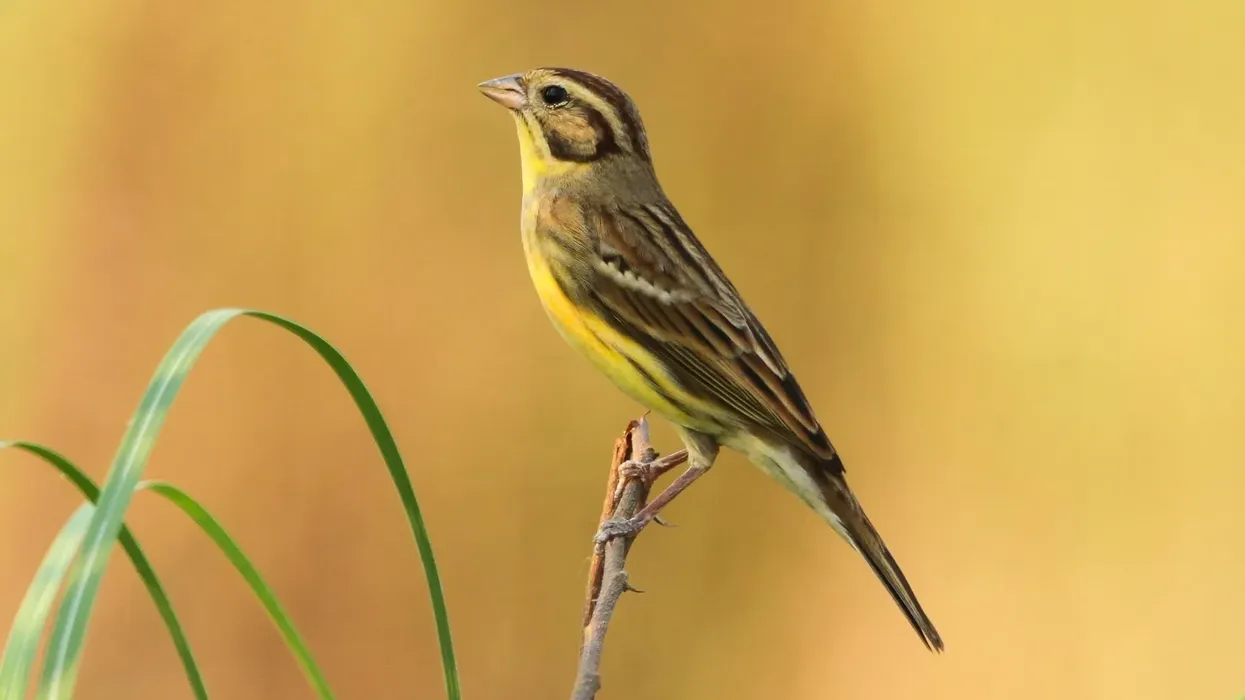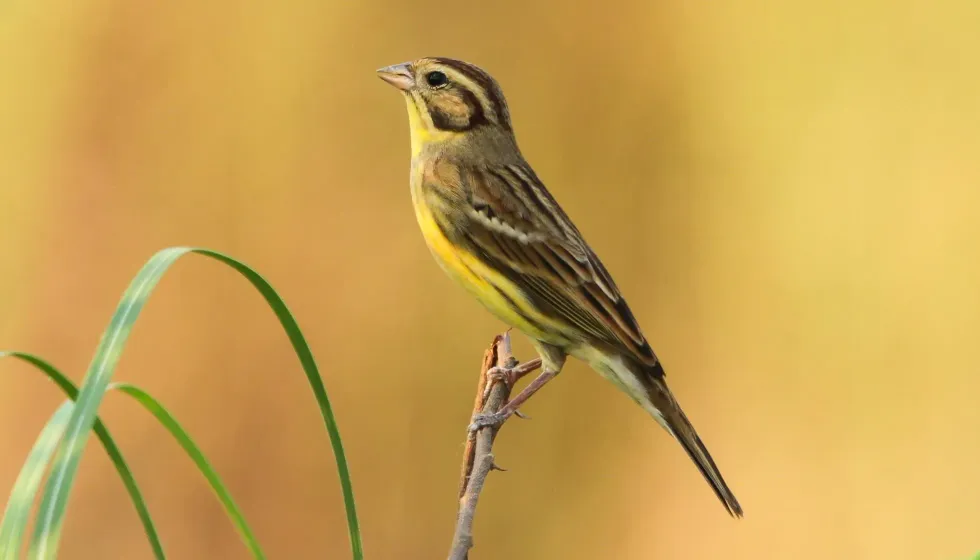There is a total of 50 species of bunting birds in the world. The yellow-breasted bunting (Emberiza aureola) is classified as critically endangered by the International Union For Conservation Of Nature (IUCN). The major threats they face apart from animal predators are humans.
Hunters travel distances to find these birds. The hunting activities take place primarily in China. Apart from this, they are also at threat of habitat loss.
The yellow-breasted bunting (Emberiza aureola) is seen on farms, in grasslands, and wetlands in regions including Finland, India, and southern China. These birds are omnivorous beings and enjoy feeding on insects a well as seeds.
These birds are migratory in nature They migrate to parts of Asia during winter. These birds are popularly known as 'rice birds' in China. Male and female birds are slightly different in appearance.
For more relatable content, check out our fact files on the painted bunting and snow bunting.
Yellow-breasted Bunting Interesting Facts
What type of animal is a yellow-breasted bunting?
The yellow-breasted bunting is a bird that belongs to the kingdom Animalia and order Passeriformes.
What class of animal does a yellow-breasted bunting belong to?
The yellow-breasted bunting is a bird that belongs to the class Aves, the family Emberizidae, and the genus Emberiza.
How many yellow-breasted buntings are there in the world?
Yellow-breasted bunting's exact population size is not evaluated. They are classified as a critically endangered species by the IUCN red list.
Where does a yellow-breasted bunting live?
The yellow-breasted bunting habitat range constitutes farms, grasslands, and wetlands. Yellow-breasted bunting is found in places like Finland, India, and southern China. They are a migratory bird species.
What is a yellow-breasted bunting's habitat?
The yellow-breasted bunting habitat range is seen in both dry as well as wet meadows. They migrate to parts of Asia during winter to save themselves from the harsh climates. They build nests on the ground close to their habitats.
Who do yellow-breasted buntings live with?
Yellow-breasted buntings live as solitary beings as well as in pairs. The birds primarily reside close to their habitat range and build nests on the ground.
How long does a yellow-breasted bunting live?
The average lifespan of this bird is estimated at seven years. Their lifespan is dependent on their habitat, and diet patterns.
How do they reproduce?
Yellow-breasted bunting breeding season from mid-June to early July. They produce a single brood per season. Breeding pairs stay together until the end of the breeding season. Females build nests close to the ground.
The nest is usually built using grass, stalks, and other materials available within their habitat range. These birds build nests and post-mating they lay four to five eggs. The eggs have darker markings.
Incubation lasts 13-14 days. Females are more involved in raising their young as compared to males. Fledging occurs 11-14 days post-hatching prior to flying. They become independent only one or two weeks post-fledging.
What is their conservation status?
The yellow-breasted bunting IUCN classifies the species as a Critically Endangered species. The IUCN red list contains information related to most animal species you could find more information on the web.
Yellow-breasted Bunting Fun Facts
What do yellow-breasted buntings look like?
Male yellow-breasted buntings as per description have brown chestnut upper parts and breast bands. They have blackish flanks and streaks. Their streaks are visible if observed closely. Their black face and upper throat contrast strongly with bright yellow underparts.
Their flight feathers are brown with narrow pale edges. Their tail is dark brown. They have a small head with chestnut brown eyes. Their legs and feet are pinkish.

How cute are they?
These birds are extremely cute. They are small to medium-sized birds although they have become rare due to exploitative practices that have majorly put their population under threat.
How do they communicate?
Yellow-breasted bunting call is short and metallic. When they are on breeding grounds they give out an abrupt 'chup' sound when flushed. The song is usually described as a far crying monotonous rising jingle of clear, ringing notes falling at the end sounding like tru-tru-tree-tree-tri-tri-iih-tiu or 'do-do-dee-dee-do-de'.
How big is a yellow-breasted bunting?
Yellow-breasted bunting 5.5-5.9 in (14-15 cm) in length, which is two times bigger than tit as a tit is is 3.9-4.5 in (10-11.5 cm) in length.
How fast can a yellow-breasted bunting fly?
The yellow-breasted bunting flying speed is moderately fast. These birds are a migratory species and can travel long distances.
How much does a yellow-breasted bunting weigh?
Yellow-breasted bunting weighs 0.03- 0.07 lb (14-33 g). These birds are small-sized and require an equal amount of intake from both insects as well as seeds or grains.
What are the male and female names of the species?
Male and female birds are not addressed differently. They are slightly different in coloration and also differ in reproductive functions.
What would you call a baby yellow-breasted bunting?
Baby yellow-breasted bunting is called a nestling. The juvenile bird is dependent on its parents for food and shelter. The young are fed the same food as adults once they hatch.
What do they eat?
Yellow-breasted bunting is primarily an omnivore and feeds on insects as well as seeds. They have particular sites on which they choose to forage on.
Some insects they feed on include flatworms, ants, dung beetles, lizards, and other insects. They forage for food in Finland and migrate to parts of Asia during extreme climates. Predators include raccoons, feral cats, opossum like Virginia opossum.
Are they dangerous?
These bird species are not dangerous. Yellow-breasted bunting is scarcely seen owing to the fact that their populations are scarce. Their instant response to any form of danger is their flight instinct.
Would they make a good pet?
Migration is primary in the yellow-breasted bunting and these birds are not ideal to be adopted. This bird species is in danger and their population is under threat. If you wish to see this bird species you could find birdwatching sites endemic to these species. If you wish to consider adoption you could consider other sociable birds.
Did you know...
An 'e-bird' website online has access to information related to bird species specifically in North America as well as other parts of the world. The 'e-bird' website also contains information related to their range map about birds of North America and other interesting information related to species in the world.
There are nine species of bunting in North America. The painted bunting is one such colorful species seen in eastern North America. They are native to North America. The eastern bunting bird from eastern North America is a must-see for every birdwatcher.
How many types of buntings are there?
There is a total of 50 species of bunting birds in the world. The list includes snow bunting, ciri bunting, corn bunting, juncos among others. They are different in coloration and pattern and endemic to different regions of the world.
All bunting birds are migratory. Migration occurs to escape the winter. Since its difficult for them to survive in extreme winter conditions.
Why is the yellow-breasted bunting endangered?
Yellow-breasted bunting bird is classified as under threat. The major threats which have led to their decline apart from animal predators is humans. Hunters travel distances to find these birds. The hunting activities take place primarily in China. These have majorly affected their populations.
Migration itself is a risky affair for such small bird species since it drains them out, however, owing to illegal attacks, their population has been placed under threat. If you wish to protect such birds you could join conservation efforts employed in their favor.
Some organizations include 'birdlife international'. 'Birdlife international' strives to conserve birds. This 'birdlife international' is an international non-governmental organization.
Birdlife International has various opportunities. The decline in bird population occurs primarily due to external factors like pollution and habitat loss but the decline may be impacted by other factors.
Here at Kidadl, we have carefully created lots of interesting family-friendly animal facts for everyone to discover! For more relatable content, check out these yellow warbler facts and willow warbler facts for kids.
You can even occupy yourself at home by coloring in one of our free printable bunting bird coloring pages.








